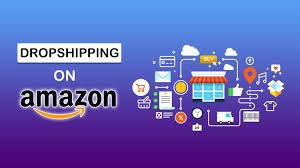Amazon Dropshipping
The allure of ecommerce beckons to many aspiring entrepreneurs. The freedom, flexibility, and potential for explosive growth are undeniable. However, the traditional model of ecommerce – purchasing inventory, managing storage, and handling fulfillment – can be daunting, especially for beginners. This is where Amazon dropshipping emerges as a potentially attractive option.
This comprehensive guide delves into the world of Amazon dropshipping, equipping you with the knowledge to navigate its intricacies and make informed decisions about its suitability for your entrepreneurial journey.
Dropshipping is a fulfillment method, not a business model in itself. Here’s the core concept:
- You list products for sale on an online marketplace like Amazon.
- When a customer places an order, you don’t hold any inventory.
- Instead, you forward the order details to a third-party supplier (dropshipper).
- The dropshipper then ships the product directly to the customer, typically under your brand name.
Essentially, you act as the middleman, connecting customers on Amazon with dropshippers who handle product storage and fulfillment.
The Allure of Amazon Dropshipping: Why Consider It?
Several factors contribute to the popularity of Amazon dropshipping:
- Low Startup Costs: No upfront inventory investment translates to lower initial costs compared to traditional ecommerce models. This allows you to test product ideas and market viability with minimal financial risk.
- Scalability: Dropshipping scales effortlessly. As your sales grow, your fulfillment needs are automatically handled by the dropshipper. This eliminates the need for managing your own warehouse or inventory levels.
- Flexibility: Dropshipping allows you to manage your business from anywhere with an internet connection. You’re not tied down by managing physical inventory or fulfillment processes.
- Wide Product Selection: By partnering with multiple dropshippers, you can offer a vast array of products to your customers on Amazon.
Before You Dive In: The Realities of Amazon Dropshipping
While dropshipping offers potential benefits, it’s crucial to understand its limitations:
- Lower Profit Margins: Since you’re not buying products in bulk, you typically have lower profit margins compared to the traditional model. This necessitates higher sales volume to achieve profitability.
- Less Control: You relinquish some control over product quality, packaging, and shipping times as you rely on the dropshipper’s capabilities.
- Competition: Amazon is a highly competitive marketplace. Standing out requires smart product selection, effective marketing strategies, and excellent customer service.
- Amazon Dropshipping Policies: Understanding and adhering to Amazon’s dropshipping policies is crucial to avoid account suspension.
Is Amazon Dropshipping Allowed? Understanding the Rules
Amazon’s dropshipping policies are generally seller-friendly. Here’s what you need to know:
- Be the Seller of Record: You are legally responsible for the sale. Ensure your dropshipper removes any branding information from the packaging and includes your business information as the seller.
- Comply with Amazon’s Terms of Service: Familiarize yourself with all of Amazon’s seller policies to avoid violating any terms and jeopardizing your account.
- Focus on Customer Satisfaction: Provide excellent customer service to maintain a positive seller rating, which is crucial for success on Amazon.
Building Your Amazon Dropshipping Business: A Step-by-Step Guide
Now that you understand the core concepts, let’s explore the steps involved in building your Amazon dropshipping business:
- Product Research: Finding Your Niche
- Identify Profitable Niches: Use tools like Jungle Scout or Helium 10 to identify product categories with high demand and low competition on Amazon.
- Focus on Products with High Perceived Value: Customers are often willing to pay a premium for unique or problem-solving products.
- Consider Product Size and Weight: Shipping costs can significantly impact your profit margins. Opt for lighter, smaller products with lower shipping fees.
- Research Competition: Analyze existing competition for your chosen products. Look for opportunities to differentiate your offerings through branding, pricing, or customer service.
- Finding Reliable Dropshipping Suppliers
- Prioritize Quality and Reliability: Look for dropshippers with a proven track record of providing high-quality products and timely shipping.
- Competitive Pricing: Negotiate competitive pricing with your dropshipper to ensure you maintain sufficient profit margins after factoring in Amazon fees.
- Minimum Order Quantities (MOQs): Some dropshippers have minimum order quantities. Ensure these align with your projected sales volume to avoid getting stuck with excess inventory.
2. Finding Reliable Dropshipping Suppliers (Continued)
- Sample Orders: Before committing to a long-term partnership, order samples from potential dropshippers to assess product quality, packaging, and shipping times.
- Communication and Support: Choose a dropshipper with responsive customer support. Clear communication is vital when resolving order fulfillment issues or product discrepancies.
- Setting Up Your Amazon Seller Account
- Choose Your Selling Plan: Individual or Professional selling plans are available on Amazon. Consider your projected sales volume to determine the most suitable option.
- Product Listing Optimization: Create compelling product listings with high-quality images, detailed descriptions, and relevant keywords to improve product discoverability on Amazon.
- Competitive Pricing Strategy: Research competitor pricing and establish competitive prices that factor in your profit margin and Amazon fees.
- Marketing and Customer Acquisition
- Leverage Amazon PPC (Pay-Per-Click) Advertising: Amazon PPC ads can significantly increase product visibility and drive traffic to your listings.
- Social Media Marketing: Promote your products on social media platforms like Facebook and Instagram to build brand awareness and attract new customers.
- Content Marketing: Create informative blog posts, videos, or infographics related to your niche to establish yourself as an authority and attract organic traffic.
- Customer Service Excellence
- Prompt Response to Inquiries: Respond to customer inquiries promptly and professionally. Aim to exceed customer expectations and build trust.
- Efficient Order Fulfillment: Monitor your dropshipper’s performance to ensure timely order fulfillment and accurate deliveries.
- Proactive Issue Resolution: Be prepared to handle customer returns, refunds, and order cancellations efficiently. Aim to resolve issues quickly and maintain positive customer relationships.
Beyond the Basics: Advanced Strategies for Success
While the steps above provide a solid foundation, consider these advanced strategies to optimize your Amazon dropshipping business:
- Brand Building: Go beyond simply reselling products. Develop a brand identity with a unique logo, color scheme, and messaging that resonates with your target audience.
- Bundling and Upselling: Create product bundles or offer upselling opportunities to increase average order value and boost your bottom line.
- Private Label Products: As your business grows, consider partnering with a manufacturer to create your own private label brand. This allows for greater control over product quality, branding, and potentially higher profit margins.
The Nitty-Gritty: Financial Considerations and Profitability
Profitability depends on various factors, including product selection, pricing strategy, advertising spend, and dropshipping costs. Here are some key financial considerations:
- Amazon Fees: Factor in Amazon’s selling fees, fulfillment fees (FBA if applicable), and referral fees when calculating your profit margins.
- Dropshipping Costs: Understand your dropshipper’s pricing structure, including product costs, shipping fees, and any additional charges.
- Marketing and Advertising Costs: Allocate a budget for marketing and advertising campaigns to drive traffic to your Amazon listings.
Tools and Resources for Success
Several tools and resources can aid you in your Amazon dropshipping journey:
- Product Research Tools: Jungle Scout, Helium 10, AMZScout
- Keyword Research Tools: Amazon Seller Central Keyword Research Tools, Google Keyword Planner
- Listing Optimization Tools: Jungle Scout Listing Builder, AMZ Product Optimizer
- Inventory Management Tools: Inventory Planner (by Amazon), Ordoro
- Marketing and Advertising Tools: Amazon Seller Central Advertising Console
The Roadmap to Success: Continuous Learning and Adaptation
The ecommerce landscape is constantly evolving. Stay ahead of the curve by:
- Staying Up-to-Date with Amazon Policies: Regularly review and adhere to Amazon’s latest policies to avoid account suspension.
- Market Trends and Consumer Behavior: Keep yourself informed on industry trends and evolving consumer preferences to adapt your product offerings and marketing strategies.
- Data Analysis and Optimization: Analyze your sales data on Amazon Seller Central to identify successful products and areas for improvement.
The Final Word: Is Amazon Dropshipping Right for You?
Amazon dropshipping offers a potentially low-cost entry point into the world of ecommerce. However, it requires dedication, strategic planning, and continuous optimization to achieve long-term success. Carefully weigh the pros and cons, conduct thorough research, and develop a solid business plan before embarking on your Amazon dropshipping journey. With the right approach and commitment, you can leverage this model to build a thriving online business.
**Remember, success in Amazon dropshipping, or any ecommerce venture, doesn’t happen overnight. Be patient, persistent, and continuously learn to navigate the ever-evolving landscape. By combining the strategies outlined in this guide.



